Islamic Republic of Iran Railways
The Islamic Republic of Iran Railways (abbreviated as IRIR, or sometimes as RAI) (Persian: Rāhāhane Jomhuriye Eslamiye Irān) is the national state-owned railway system of Iran. The Raja Passenger Train Company is an associate of the IR,[1] and manages its passenger trains. The Railway Transportation Company is an associate of the IR, which manages its freight transport. The Ministry of Roads & Urban Development is the state agency that oversees the IRIR. Some 33 million tonnes of goods and 29 million passengers are transported annually by the rail transportation network, accounting for 9 percent and 11 percent of all transportation in Iran, respectively (2011).[2]
| Railway of Islamic Republic of Iran | |
|---|---|
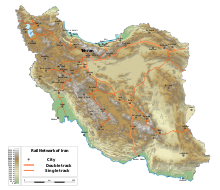 Iran railway 2020 | |
| Operation | |
| National railway | Rahahane Jomhorie Eslamiye Iran |
| Major operators | RAI, Tooka rail, Samand rail, |
| Statistics | |
| Ridership | 21 million |
| Passenger km | 13 billion |
| Freight | 31 million tonnes |
| System length | |
| Total | 12,998 kilometres (8,077 mi) |
| Double track | 1426 km |
| Electrified | 146 km |
| Track gauge | |
| Main | 1,435 mm (4 ft 8 1⁄2 in) |
| Electrification | |
| Main | 25 kV 50 Hz AC |
| Features | |
| No. tunnels | 105 |
| Tunnel length | 120 km |
| Longest tunnel | 3000 m |
| No. bridges | 350 |
| Longest bridge | 750 m |
| No. stations | 360 |
| Highest elevation | 2500 m |
| Lowest elevation | -20 m |
History
Qajar dynasty
In 1886, during the time of Nasser-al-Din Shah, an 8.7 km 1,000 mm (3 ft 3 3⁄8 in) metre gauge horse-driven suburban railway was established south of Tehran, which was later converted to steam. This line was closed in 1952. The First Iranian railway was set up in 1887 between Mahmudabad and Amol; its construction was completely private. However it was not used because of several problems.[3][4] The Tabriz–Jolfa line (146 km) was built in 1914, the Sufiyan–Sharafkhaneh line (53 km) in 1916, and the Mirjaveh–Zahedan line (93 km) in 1920.
World War II
The 1,392 km (865 mi) long Trans-Iranian Railway from Bandar Shah (now Bandar Torkaman) on the Caspian Sea to Bandar Shahpur (now Bandar-e Emam Khomeyni) on the Persian Gulf was opened during the reign of Reza Shah Pahlavi in 1939. The railroad was built with rail weighing 33 kilograms per metre (67 lb/yd) and required more than 3000 bridges. There were 126 tunnels in the Zagros mountains, the longest of which was 2.4 kilometres (1.5 mi). Grades averaged 1.5 percent south of Tehran, but then increased to 2.8 percent to cross the 2,220-metre (7,270 ft) pass between Tehran and the Caspian Sea.
Anglo-Soviet Invasion of Iran
After the Anglo-Soviet invasion of Iran in 1941, this Persian Corridor became one of the supply routes for war material for the Soviet Union during World War II (Railway trend in Iran). The invading British built a 121-kilometre (75 mi) branch line from the 2,953-foot (900 m) bridge over the Karun River in Ahvaz to a new southern port at Khorramshahr on the Arvand Rud river. In 1943, 3,473 American soldiers of the Military Railway Service began running trains between the Persian Gulf and Caspian Sea using ALCO RS-1 locomotives rebuilt with 3-axle trucks and designated RSD-1.[5] The Americans set up headquarters in Ahvaz, but were unable to tolerate the daytime heat, and generally operated the railway at night.[6] The Persian Gulf Command ran trains day and night.[7]
Challenging construction
The Trans-Iranian railway traverses many mountain ranges, and is full of spirals and 1 in 36 (2.78%) ruling grades. Much of the terrain was unmapped when construction took place, and its geology unknown. Several stretches of line, including tunnels, were built through unsuitable geology, and had to be replaced before the line opened. Nevertheless, the line was completed ahead of schedule. In recent years the railways have undergone significant extensions including the 1977 linking to the western railway system at the Turkish border, the 1993 opening of the Bandar Abbas line providing better access to the sea, and the 1996 opening of the Mashad–Sarakhs extension as part of the Silk Road railway to link to the landlocked Central Asian Countries.
Railway construction
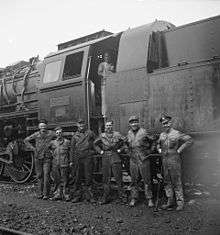
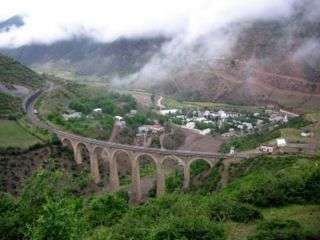
In December 2014, a rail line from Iran opened to Turkmenistan and Kazakhstan. The opening of the line marks the first direct rail link between Iran, Kazakhstan and China, and upon completion of the Marmaray rail project direct rail transport between China and Europe (while avoiding Russia) will be possible.[8][9]
| Start | End | Length in km | Start | End |
|---|---|---|---|---|
| of Route | of Construction | |||
| Tabriz | Jolfa | 148 | 1912 | 1916 |
| Zahedan | Mirjaveh | 94 | 1920 | 1921 |
| Tehran | Bandar Shah | 461 | 1928 | 1938 |
| Tehran | Bandar Shahpur | 928 | 1928 | 1939 |
| Ahvaz | Khorramshahr | 121 | 1942 | 1943 |
| Sar Bandar | Mahshahr | 12 | 1950 | 1951 |
| Garmsar | Mashhad | 812 | 1938 | 1958 |
| Tehran | Tabriz | 736 | 1939 | 1959 |
| Gorgan | Bandar Shah | 35 | 1960 | 1961 |
| Tabriz | Bazargan | 192 | 1912 | 1971 |
| Qom | Zarand | 847 | 1939 | 1971 |
| Isfahan | Zarrin Shahr | 111 | 1969 | 1972 |
| Zarand | Kerman | 80 | 1975 | 1979 |
| Bafq | Bandar-Abbas | 626 | 1982 | 1995 |
| Mashhad | Sarakhs | 165 | 1993 | 1997 |
| Aprin | Maleki | 24 | 1993 | 1997 |
| Badrud | Meibod | 254 | 1996 | 1998 |
| Aprin | Mohammediya-2 | 122 | 1994 | 1999 |
| Chadormalu | Meibod | 219 | 1992 | 1999 |
| Mohammediya-2 | Mohammediya-1 | 6 | 1994 | 1999 |
| Bafq | Kashmar | 800 | 1992 | 2001 |
| Kerman | Bam | 225 | 1999 | 2002 |
| Bam | Zahedan | 546 | 2000 | 2009 |
| Isfahan | Shiraz | 506 | 2001 | 2009 |
| Khorramshahr | Shalamcheh | 16 | 2009 | 2012[10] |
| Gorgan | Incheh Borun | 80 | 2012 | 2013[11] |
| Tehran | Hamedan | 268 | 2001 | 2017[12] |
| Arak | Kermanshah | 267 | 2001 | 2018[13] |
| Qazvin | Rasht | 164 | 2006 | 2018[14] |
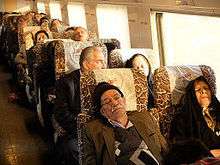
Rolling stock
Iran Railways uses a variety of rolling stock for their services. Trains are operated with diesel and electric locomotives. Steam locomotives have been phased out. Diesel is a strategic industry, and by using this heavy oil as a fuel instead of gas for locomotives, the Islamic Republic of Iran has joined the 12 world countries which manufacture this type of engine.[15]
Operations
In 2008, the IR operated 11,106 km of rail with a further 18,900 km in various stages of development.[16] Almost all of this is standard gauge of 1,435 mm (4 ft 8 1⁄2 in), but 94 km are Russian gauge of 1,520 mm (4 ft 11 27⁄32 in) to link up to ex-Soviet Union border states. There is also the no-longer-isolated Indian gauge section of 1,676 mm (5 ft 6 in) from Zahedan to the Pakistan border that continues to Quetta and the Indian sub-continent. The extent of double-track lines is 1,082 km. The Jolfa–Tabriz line is electrified( 148 km). In 2006, IR reported that it possessed 565 engines, 1,192 passenger coaches, and 16,330 wagons. The vast majority of the engines are diesel-powered.
Expansion

The majority of transportation in Iran is road-based. The government plans to transport 3.5% of the passenger volume and 8.5% of the freight volume by rail. Extensive electrification is planned. The railway network expands by about 500 km per year according to the Ministry of R&T. According to plan, Iran’s railway lines are to reach 15,000 kilometers by 2015 and 25,000 kilometers by the year 2025.[17][18] The State Railways Company has 300 locomotives with an average lifespan of 40 years.[19] The Islamic Republic of Iran Railways, the Iran Power Plant Projects Management (Mapna) and Germany's Siemens have signed a contract for 150 IranRunner locomotives for passenger trains. Siemens is committed to exporting to Iran some 30 locomotives in the first phase, and to manufacturing another 120 using domestic capacities and expertise over the next 6 years (2007). MLC (Mapna Locomotive Engineering and Manufacturing Company) is the manufacturing company responsible for this production. Another locomotive manufacturer in Iran is Wagon Pars which builds AD43C locomotives in partnership with Iranian power plant maker DESA diesel.[20] In 2009, €17 billion in foreign investment in the rail industry has been secured, according to the Ministry of Road and Transportation of Iran.[21]
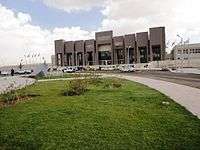
Affiliate companies
- Raja Passenger Train Company is an associate of the Islamic Republic of Iran Railways (IRIR) and manages its passenger trains, including international trains linking Tehran to Istanbul and Damascus. Raja Passenger Train Company carried more than 4 million passengers during 2003-05. The number of passengers traveling by rail increased from 11.7 million in 2000 to 17.3 million in the year ending March 2005. Every passenger wagon annually carries 7,340 passengers per kilometer on average (whereas the figure is 3,950 people per kilometer in Turkey and 5,220 passengers per kilometer in Egypt). Private enterprises are expected to operate 5,000 wagons by 2009 (50% of total).[19]
- Railway Transportation Company is also a subsidiary of the IRIR which manages its freight transport while the Ministry of Roads and Transportation is the state agency that oversees the IRIR. In Iran, for every wagon, some 1,050 tons of freight are being transported (2008).[19] The cargo rail system between Iran, Turkey and Pakistan will begin regular operations by August 2010.[22]
- Zarand Company provides the national railroad system with freight and passenger train carriages.[23]
Network and corridors
The railway network converges on Tehran. The Iranian cities of Isfahan and Shiraz were linked to Tehran in 2009. Further extension of this line to Bushehr and Bandar Abbas is planned. Furthermore, the construction of Chabahar-Zahedan-Mashhad railway, extending from southeast to northeast of the country to the length of 1,350 kilometers, started in 2010 with 3 billion euro credit.[24] The western railway extension links to Turkey at the Rāzī–Kapıköy border. There is a northern connection to Azerbaijan, the Caucasus, and Russia has a bogie-changing station at the border at Jolfa. The southern routes connect Tehran to the Persian Gulf ports of Bandar Imam and Bandar Abbas. A line to the Caspian Sea ends at the terminal of Amir Abad and at Bandar Torkaman, and is part of a North-South corridor to Russia and Scandinavia. The north-east corridor connects Mashhad and continues further to the bogie-changing station at Sarakhs. For the landlocked countries of Turkmenistan, Uzbekistan, Tajikistan, Kyrgyzstan, and Kazakhstan this line provides access to the sea. A recent connection from Mashhad to Bafq has significantly shortened access to the port city of Bandar Abbas. Tehran-Mashhad with a length of 900 kilometers, Tehran-Qom-Esfahan with a length of 410 kilometers (under construction), Qazvin-Rasht-Anzali-Astara with a length of 370 kilometers; will all be built with help from China at a cost of $12 billion.[25] In total, Iran has signed a number of contracts with China for the development of 5,000 kilometres of railway lines.[18]
North-South Railway
The North-South railway is complete between Qazvin and Bandar Abbas; the line was expected to be completed as far as Azerbaijan by the end of 2016.[26] Qazvin to Astara is the missing link in the North-South Transportation Corridor, which links India, Iran, Azerbaijan, Russia and Finland. Qazvin Rasht railway was completed in 2018 and Rasht Astara railway needs another four years to be completed.[27]
Links to Azerbaijan and Armenia
Iran's first rail link to the outside world appeared simultaneously with the beginning of the country's railway system, as Iran's first major railway (1916) connected Tabriz with Jolfa on the border with the Russian Empire. The link continued its importance throughout the USSR era; Iran and the USSR signed an agreement on cross-border rail transport in 1940, and amended it in 1958.[28] It is reported that during the late-Soviet era, some 350 railcars crossed the border at Jolfa daily, with the annual amount of cross-border freight reaching 3.5 million tons.[29] However, after the breakup of the USSR and the closing of the border between Armenia and Azerbaijan the Jolfa connection became a dead end, as it only links Iran with the isolated Nakhichevan exclave of the Republic of Azerbaijan.[30] In 2007, Iranian Railways, Azerbaijan State Railway and Russian Railways agreed on implementing the project to build a new line between Qazvin, Resht, Astara, Iran and Astara, Azerbaijan. In April 2017, Russia and India celebrated 70 years of diplomatic relations and vowed to complete the North-South Transportation Corridor (NSTC) with the help of Iran. The NSTC reduces time and cost of travel by 30-40%.[31]There is presently no direct railway connection between Iran and Armenia, even though the two countries share a border. In 2009, Iran and Armenia agreed to build a railway linking Armenia with Iran’s Persian Gulf ports.[32]
Links to Central Asia
In 1996, Mashhad–Sarakhs extension connected Iran to Turkmenistan,as part of the Silk Road railway to link to the landlocked Central Asian Countries.Former states of the Soviet Union have railways using a 1,520 mm (4 ft 11 27⁄32 in) Russian gauge,thus the Iranian Railways maintain break-of-gauge services at borders to Azerbaijan and Turkmenistan,and beyond brief wide-track rail segments to the border crossing.The Kazakhstan-Turkmenistan-Iran railway link is a part of the North-South Transport Corridor and is a 677 km (421 mi)long railway line connecting the Central Asian countries of Kazakhstan and Turkmenistan with Iran and the Persian Gulf.It will link Uzen in Kazakhstan with Bereket - Etrek in Turkmenistan and end at Gorgan in Iran's Golestan province.In Iran,the railway will be linked to national network making its way to the ports of the Persian Gulf.The project is estimated to cost $620m which is being jointly funded by the governments of Kazakhstan,Turkmenistan and Iran.[33]
Links to Iraq, Syria and Afghanistan
Feasibility studies were started on Khorramshahr-Basra and Kermanshah-Baghdad links with Iraq.[34] As of 2014, the Iranian line to Khorramshahr was finished,[35] but construction had not started on the track from the Iraqi border to Basra. In 2017, the West Corridor was expanded from Arak to Malayer and Kermanshah. The Iranian government plans on expanding the network further to Khosravi (Iran-Iraq) border by 2018.[36] Mashhad-Khvaf-Afghanistan's Border-Islam Qala railway is being constructed by an Iranian firm, with funding from the Afghan government, but the section in Afghanistan remains incomplete.[36][37][38]
Link to Turkey, and International Standard Gauge route to Europe
In 1977, the Iranian railways linked to the western railway system at the Turkish border. The route to the west into Turkey terminates at Van with a 90 km (56 mi) train ferry for both freight wagons and international passenger traffic (baggage car only) across Lake Van, which is at an altitude of 1,650 m (5,413 ft), to Tatvan where it joins the Turkish standard-gauge network.
Link to Pakistan
The construction of the railway from Bam to Zahedan was completed in early 2009 connecting Tehran to Pakistan border with an opening ceremony on 19 July 2009.[39] However international container traffic commenced operations on 14 August 2009 with transshipment (or transloading) between 1,676 mm (5 ft 6 in) and 1,435 mm (4 ft 8 1⁄2 in) standard gauge wagons in the Gulf, Western Texas and Pacific Railway Zahedan Exchange Yard on the bypass line.[40] The freight traffic was discontinued however after the initial trial trains, and was only revived in 2015.[41] Iranian Railways have been trying to persuade Pakistan Railways to convert its route to Quetta to standard gauge, in order to facilitate the flow of international traffic to Europe. Pakistan responded in 2006 with a statement that it is to convert its network to standard gauge, and would plan a link with the standard gauge system of China. A through passenger service is being considered[40][42] to supplement the occasional Quetta-Zahedan service, itself a poor shadow of the former Pakistan-Iran 'Taftan Express'.
International railway links with neighboring countries
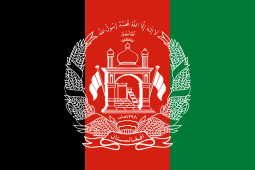


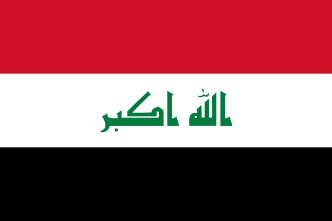


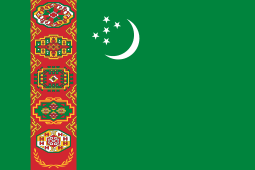
Railway electrification
Although railway electrification in Iran was started in 1975, it was halted for almost 30 years. A contract for electrification of the Tehran-Mashhad double-track line and the supply of 70 electric locomotives was awarded in 2009.[43] Speeds of up to 200 km/h for locomotive-hauled passenger trains and 250 km/h for tilting EMUs are expected to reduce existing journey times of 7.5 to 12 to less than 5 hours. As recently as July 2017 the Iranian Government has completed a loan agreement for the Tehran – Mashhad electrification project. Works on this project are expected to begin shortly.
Commuter Railway services
Local Rail, also referred to as Suburban Rail or Commuter rail when originating from a large city and covering its suburbs, is a class of rail services, using railbus-type trains, running a distance of about 50 km to 200 km, and serving all stations.[44] Currently there are the following services:
Iran Tehran Railway Dept. | ||||||||||||||||||||||||||||||||||||||||||||||||||||||||||||||||||||||||||||||||||||||||||||||||||||||||||||||||||||||||||||||||||||||||||||||||||||||||||||||||||||||||||||||||||||||||||||||||||||||||||||||||||
|---|---|---|---|---|---|---|---|---|---|---|---|---|---|---|---|---|---|---|---|---|---|---|---|---|---|---|---|---|---|---|---|---|---|---|---|---|---|---|---|---|---|---|---|---|---|---|---|---|---|---|---|---|---|---|---|---|---|---|---|---|---|---|---|---|---|---|---|---|---|---|---|---|---|---|---|---|---|---|---|---|---|---|---|---|---|---|---|---|---|---|---|---|---|---|---|---|---|---|---|---|---|---|---|---|---|---|---|---|---|---|---|---|---|---|---|---|---|---|---|---|---|---|---|---|---|---|---|---|---|---|---|---|---|---|---|---|---|---|---|---|---|---|---|---|---|---|---|---|---|---|---|---|---|---|---|---|---|---|---|---|---|---|---|---|---|---|---|---|---|---|---|---|---|---|---|---|---|---|---|---|---|---|---|---|---|---|---|---|---|---|---|---|---|---|---|---|---|---|---|---|---|---|---|---|---|---|---|---|---|---|
| ||||||||||||||||||||||||||||||||||||||||||||||||||||||||||||||||||||||||||||||||||||||||||||||||||||||||||||||||||||||||||||||||||||||||||||||||||||||||||||||||||||||||||||||||||||||||||||||||||||||||||||||||||
- Tehran
- Tabriz
- Khuzestan
- Ahvaz (Karun Station)-Sarbandar
- Ahvaz (Karun Station)-Bandar-e Mahshahr
- Ahvaz (Ahvaz Station)-Khorramshahr
- Ahvaz (Ahvaz Station)-Andimeshk
- Andimeshk-Dorud
- Lorestan
- Mashhad
- Mazandaran-Golestan (Shomal Division)
- Gorgan-Pol-e Sefid
- Gorgan-Incheh Borun
- Qazvin
High-speed rail
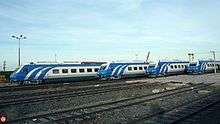
Currently there is one high speed railway line under construction between Tehran and Isfahan passing through Qom. The length of the line is 410 km; completion is planned for 2021.
Construction of another high speed rail line between Qom and Arak is planned as well.[45]
See also
- Iranian railway industry
- Rah Ahan FC
- Railway stations in Iran
- DESA diesel
- Tehran Metro
- North–South Transport Corridor
- Ashgabat agreement, a Multimodal transport agreement signed by India, Oman, Iran, Turkmenistan, Uzbekistan and Kazakhstan, for creating an international transport and transit corridor facilitating transportation of goods between Central Asia and the Persian Gulf.[46]
References
- Sources:
- شرکت قطارهای مسافربری رجا [Raja Passenger Trains Company], www.raja.ir (in Persian and English), archived from the original on 2 April 2009, retrieved 31 March 2009, company website
- "News Archive", www.msedv.com, RAJA Passenger Trains Operating Company, archived from the original on 6 April 2010, retrieved 14 January 2012,
Passenger Trains Operating Company, RAJA, is a joint stock company affiliated to Islamic Republic of Iran's Railway Company (RAI). It was established in October 1996 as a part of RAI restructuring process, aimed at separating passenger and freight train operations management from infrastructure maintenance and development.
- "Archived copy". Archived from the original on 4 February 2012. Retrieved 9 February 2012.CS1 maint: archived copy as title (link)
- "Railroads i. The First Railroad Built and Operated in Persia". Archived from the original on 26 June 2019. Retrieved 26 June 2019.
- Persia and the Persian Question
- Pinkepank, Jerry A. The Second Diesel Spotter's Guide 1973 Kalmbach Books p.233
- DeNevi & Hall United States Military Railway Service (1992) Boston Mills Press ISBN 1-55046-021-8 pp.8&73-77
- "Persian Gulf Command" by Joel Sayre 1945, Random House
- "Archived copy". Archived from the original on 14 August 2019. Retrieved 4 December 2014.CS1 maint: archived copy as title (link)
- Kazakhstan-Turkmenistan-Iran Railway to Open Today, by Onur Uysal, http://railturkey.org/2014/12/03/kazakhstan-turkmenistan-iran-railway/ Archived 5 December 2014 at the Wayback Machine
- "Archived copy". Archived from the original on 10 July 2018. Retrieved 6 January 2020.CS1 maint: archived copy as title (link)
- "Archived copy". Archived from the original on 17 February 2018. Retrieved 16 February 2018.CS1 maint: archived copy as title (link)
- "Archived copy". Archived from the original on 17 February 2018. Retrieved 16 February 2018.CS1 maint: archived copy as title (link)
- "Archived copy". Archived from the original on 21 March 2018. Retrieved 20 March 2018.CS1 maint: archived copy as title (link)
- "Archived copy". Archived from the original on 21 May 2020. Retrieved 21 May 2020.CS1 maint: archived copy as title (link)
- "Iran Displays 1st Home-Made Locomotive with Diesel Engine". Fars News Agency. 29 March 2011. Archived from the original on 1 May 2011. Retrieved 17 April 2011.
- "راه آهن ج.ا.ا". Archived from the original on 15 August 2012. Retrieved 9 April 2008.
- "Archived copy". Archived from the original on 13 September 2012. Retrieved 7 January 2012.CS1 maint: archived copy as title (link)
- "Archived copy" (PDF). Archived (PDF) from the original on 9 August 2011. Retrieved 1 February 2011.CS1 maint: archived copy as title (link)
- "Rail Privatization Underway". Iran Daily. 16 December 2008. Archived from the original on 30 January 2009.
- "Iran Manufactures 1st Express Train". Iran Daily. 3 February 2007. Archived from the original on 5 February 2007.
- "17 Billion Euro Foreign Investment in Rail Industry". Payvand.com. Mehr News Agency. 19 August 2009. Archived from the original on 2 September 2009. Retrieved 4 September 2009.
- "Archived copy". Archived from the original on 12 August 2010. Retrieved 9 June 2010.CS1 maint: archived copy as title (link)
- "Privatizing Railways". Iran Daily. 30 December 2006. Archived from the original on 12 January 2007.
- "Archived copy". Archived from the original on 11 May 2010. Retrieved 10 May 2010.CS1 maint: archived copy as title (link)
- "Archived copy". Archived from the original on 19 January 2011. Retrieved 8 January 2011.CS1 maint: archived copy as title (link)
- "IRAN". Railways Africa. Archived from the original on 3 April 2012. Retrieved 1 December 2010.
- "Archived copy". Archived from the original on 10 July 2017. Retrieved 24 June 2017.CS1 maint: archived copy as title (link)
- СОГЛАШЕНИЕ О СОВЕТСКО-ИРАНСКОМ ЖЕЛЕЗНОДОРОЖНОМ СООБЩЕНИИ (МОСКВА, 20 ЯНВАРЯ 1958 Г.) (Agreement on Soviet-Iranian railway communications; Moscow, 20 January 1958)
- На торговом пути «Север — Юг» Archived 8 July 2011 at the Wayback Machine (The North-South trade route) (in Russian)
- Georgia to remain vital transit route for Armenia Archived 2009-11-18 at the Wayback Machine. Quote: "However, there are no expectations that in the near future there will be a resolution of the Karabakh conflict and the railroads connecting Armenia and Azerbaijan - Yerevan-Nakhichevan-Baku and Ichevan-Baku - will begin operating."
- North–South Transport Corridor
- "Archived copy". Archived from the original on 22 June 2009. Retrieved 8 August 2010.CS1 maint: archived copy as title (link)
- "North-South Transnational Corridor". railway-technology.com. Archived from the original on 25 March 2014. Retrieved 25 March 2014.
- "Iran Iraq links". Railway Gazette International. 1 September 2005. Archived from the original on 7 June 2012. Retrieved 2 December 2009.
- "Archived copy". Archived from the original on 4 October 2019. Retrieved 17 March 2014.CS1 maint: archived copy as title (link)
- Charles Recknagel (14 October 2010). "Afghanistan's First New Railroad On Track". Radio Free Liberty/Radio Free Europe. Archived from the original on 19 January 2011. Retrieved 31 July 2011.
Iran has reportedly completed two-thirds of a 190-kilometer rail bed from its town of Khaf to link with Herat.
- "Iranian engineer brings roads, rail to Afghan west". Reuters. 17 April 2010. Archived from the original on 24 September 2015. Retrieved 1 July 2017.
- "FM Official Underlines Iran's Growing Aid to Afghanistan". Fars News Agency. 4 July 2011. Archived from the original on 14 March 2012. Retrieved 31 July 2011.
'The great project of Khaf-Herat railway - operation of which has also been commenced - will create a significant development in transit and connecting Afghanistan with regional and extra-regional (Europe) countries. Its connection to the railway of Central Asia, Turkey and Europe via Iran and also its connection to Iran's nationwide railways network - which will stretch from Bandar Abbas to Afghanistan - can play an important role in economic growth and development of Afghanistan,' the foreign ministry official said.
- "Pakistan - Iran - Turkey container train". Archived from the original on 6 October 2011. Retrieved 19 July 2009.
- "Islamabad-Istanbul freight train to start on 14 Aug". Archived from the original on 17 September 2009. Retrieved 22 November 2009.
- "restart Pakistani Iran freight trains". Archived from the original on 19 July 2015. Retrieved 21 September 2015.
- "Passenger service". Archived from the original on 7 June 2011. Retrieved 17 August 2009.
- "Tehran - Mashhad electrification contract". Railway Gazette International. 4 March 2009. Archived from the original on 13 August 2012. Retrieved 2 December 2009.
- "Archived copy". Archived from the original on 23 September 2016. Retrieved 22 September 2016.CS1 maint: archived copy as title (link)
- http://www.globaltenders.com/gtblogs/construction-of-high-speed-rail-line-project-iran/
- "The Hans India - India accedes to Ashgabat agreement". Archived from the original on 3 August 2017. Retrieved 17 April 2016.
External links
- Iran's Official Universal Tourism Portal
- Raja Rail Transport Company (Buying Iran Train Tickets) Website
- Ministry of Roads & Urban Development Of Iran Official Website
- Islamic Republic of Iran Railways Official Website
- Iranian Rail Industries Development Co (IRICO) Official Website
- Unofficial website
- 2005 update on status of Iran's railways
- Videos
- Iran Railways - Part I Part II - Part III - PressTV documentary